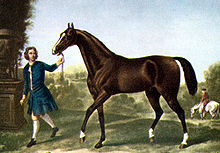Thomas Darley
Thomas Darley (born May 19, 1664 at Aldby Park , Buttercrambe , † March 9, 1704 in Aleppo ) was a younger son of the English Darley gentry family and worked as a merchant for the Levant Company in Aleppo, where he dealt with British woolen fabrics and Persian silks acted. As a so-called factor , he was the on-site representative of his trading company and was the point of contact in all matters, passed reports and information on to the headquarters and was responsible for goods logisticssuch as the correct storage and / or further transport. Members of the Levant Company also took on the diplomatic twisting of England towards the Ottoman Empire to a certain extent, which is why Harley is also referred to as consul in some biographies.
Darley's career as a businessman for the Levant Company was not particularly successful. The typical career of such a businessman involved returning six to ten years later to take on a more significant role in the trading company or embark on a political career. Darley, on the other hand, lived in Aleppo for 18 years and was now so heavily in debt that his father had to redeem him with a sum of 500 pounds sterling . He had started his career in Aleppo when the Levant Company was past its prime. England increasingly obtained its silk fabrics from Italy or directly from Bengal and China, while cotton fabrics from the Caribbean also increasingly played a role in Great Britain. The rise of the East India Company had reduced the Levant Company's market share, and increasing piracy and gangs had resulted in the loss of merchandise.
Darley's historical importance goes back to the purchase of an Arabian stallion in 1702, who was named Darley Arabian after him . Christopher McGrath describes this purchase as the most significant single transaction in horse breeding history. Despite an export ban, the stallion was sent from Darley to his family in Aldby Park, where he was used as a sire. His offspring stood out for their great racing performance, so that they played a dominant role in the breeding of the English thoroughbred. According to a study published for the first time in 2001 and subsequently confirmed several times, 95% of all English thoroughbreds can be traced back to this stallion in the paternal line alone. At least in the paternal line he has largely displaced the two other founder stallions of the English thoroughbred Byerley Turk and Godolphin Barb .
literature
- Christopher McGrath: Mr. Darley's Arabian - High Life, Low Life, Sporting Life: A History of Racing in Twenty-Five Horses . John Murray, London 2016, ISBN 978-1-84854-984-5 .
Individual evidence
- ↑ McGrath: Mr. Darley's Arabian . Chapter "The most esteemed race amongst the Arrabs both by Syre and Dam" , E-Book position 333.
- ↑ McGrath: Mr. Darley's Arabian . Chapter "The most esteemed race amongst the Arrabs both by Syre and Dam" , E-Book position 328.
- ↑ McGrath: Mr. Darley's Arabian . Chapter "The most esteemed race amongst the Arrabs both by Syre and Dam" , E-Book position 444.
- ↑ Archived copy ( memento of the original from March 11, 2007 in the Internet Archive ) Info: The archive link was inserted automatically and has not yet been checked. Please check the original and archive link according to the instructions and then remove this notice.
- ↑ 95% of thoroughbreds linked to one superstud . In: New Scientist , September 6, 2005.
| personal data | |
|---|---|
| SURNAME | Darley, Thomas |
| BRIEF DESCRIPTION | Merchant for the Levant Company in Aleppo |
| DATE OF BIRTH | May 19, 1664 |
| PLACE OF BIRTH | on Aldby Park , Buttercrambe |
| DATE OF DEATH | March 9, 1704 |
| Place of death | Aleppo |
